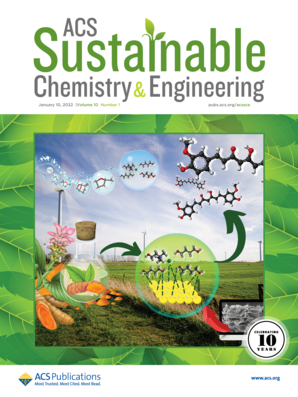Engineering Halomonas bluephagenesis for Efficient Production of Poly-3-hydroxybutyrate Bioplastics Using CO2-Derived Ethanol
IF 7.1
1区 化学
Q1 CHEMISTRY, MULTIDISCIPLINARY
引用次数: 0
Abstract
Engineering microbial cell factories to convert CO2 into high-value chemicals represents a promising avenue toward achieving carbon neutrality and sustainable development. Halomonas bluephagenesis, a halophilic bacterium exhibiting a rapid growth rate in saline and alkaline environments, has been developed for cost-effective production of poly-3-hydroxybutyrate (PHB), ectoine, and other block chemicals. Here, we first investigated the natural ethanol assimilation pathways of H. bluephagenesis and developed the strategies to synthesize PHB using CO2-derived ethanol as the carbon source. Ethanol degradation route and crucial metabolic targets were elucidated through transcriptome analysis. Substrate utilization was further improved through screening and precise tuning of the expression level of key enzymes. Subsequently, by modulating the chromosomal expression of alcohol dehydrogenase and acetaldehyde acetylating dehydrogenase to balance the carbon flow, an engineered H. bluephagenesis was constructed, achieving a PHB titer of 4.24 g/L using ethanol in shake flask cultures. Finally, Clostridium ragsdalei was employed to convert CO2 and H2 into ethanol, then ethanol was utilized by H. bluephagenesis to generate PHB, reaching a PHB titer of 64.89 g/L. This study demonstrates a promising closed-loop process to synthesize biodegradable plastics from CO2.

利用co2衍生乙醇高效生产聚3-羟基丁酸酯生物塑料的工程嗜蓝单胞菌
工程微生物细胞工厂将二氧化碳转化为高价值的化学品是实现碳中和和可持续发展的有希望的途径。嗜盐单胞菌(Halomonas bluephagenesis)是一种在盐水和碱性环境中生长速度很快的嗜盐细菌,已被开发用于生产聚3-羟基丁酸酯(PHB)、异托因和其他阻滞化学品。本研究首先研究了蓝芽草(H. bluephagenesis)的天然乙醇同化途径,并研究了以co2衍生乙醇为碳源合成PHB的策略。通过转录组分析,阐明了乙醇降解途径和关键代谢靶点。通过筛选和精确调节关键酶的表达水平,进一步提高了底物利用率。随后,通过调节乙醇脱氢酶和乙醛乙酰化脱氢酶的染色体表达来平衡碳流,构建了一个工程蓝芽孢杆菌,在摇瓶培养中使用乙醇获得了4.24 g/L的PHB滴度。最后利用拉格斯达雷梭菌将CO2和H2转化为乙醇,再由蓝发芽孢杆菌利用乙醇生成PHB, PHB滴度达到64.89 g/L。这项研究展示了一个有前途的闭环过程,从二氧化碳合成可生物降解塑料。
本文章由计算机程序翻译,如有差异,请以英文原文为准。
求助全文
约1分钟内获得全文
求助全文
来源期刊

ACS Sustainable Chemistry & Engineering
CHEMISTRY, MULTIDISCIPLINARY-ENGINEERING, CHEMICAL
CiteScore
13.80
自引率
4.80%
发文量
1470
审稿时长
1.7 months
期刊介绍:
ACS Sustainable Chemistry & Engineering is a prestigious weekly peer-reviewed scientific journal published by the American Chemical Society. Dedicated to advancing the principles of green chemistry and green engineering, it covers a wide array of research topics including green chemistry, green engineering, biomass, alternative energy, and life cycle assessment.
The journal welcomes submissions in various formats, including Letters, Articles, Features, and Perspectives (Reviews), that address the challenges of sustainability in the chemical enterprise and contribute to the advancement of sustainable practices. Join us in shaping the future of sustainable chemistry and engineering.
 求助内容:
求助内容: 应助结果提醒方式:
应助结果提醒方式:


